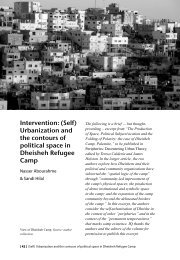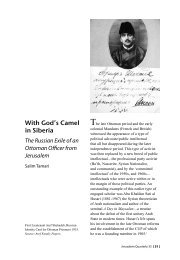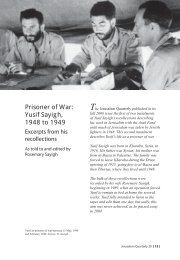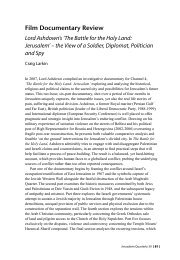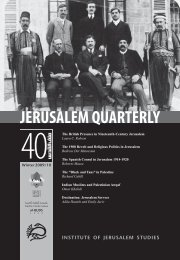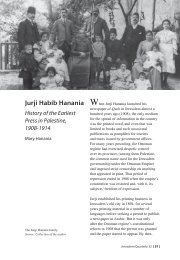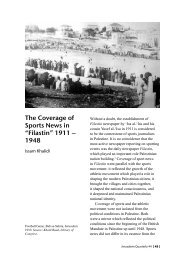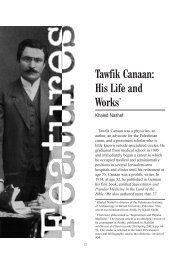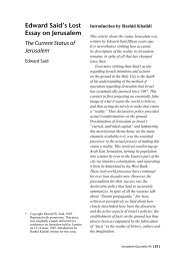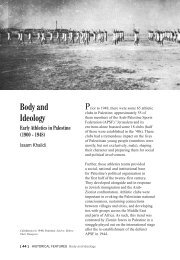PLUNDERING PALESTINE - Jerusalem Quarterly
PLUNDERING PALESTINE - Jerusalem Quarterly
PLUNDERING PALESTINE - Jerusalem Quarterly
You also want an ePaper? Increase the reach of your titles
YUMPU automatically turns print PDFs into web optimized ePapers that Google loves.
At the turn of the early 20 th century the character of archaeological work in the region<br />
underwent a methodological revolution with the beginning of stratigraphic excavations<br />
at some of the most prominent tells in the region. Simultaneously, this period saw the<br />
decline and collapse of the Ottoman Empire and the rise of competition for territory<br />
by the various European nations with vested economic and political interests in the<br />
area. The region comprising modern Israel and Palestine was ceded to the British after<br />
World War I and in June 1922 the League of Nations passed The Palestine Mandate of<br />
the League of Nations. The Mandate for Palestine was an explicit document regarding<br />
Britain’s responsibilities and powers of administration in Palestine including:<br />
“securing the establishment of the Jewish national home”, and “safeguarding the civil<br />
and religious rights of all the inhabitants of Palestine”. 14 The British Mandate period,<br />
often referred to as the ‘Golden Age of Archaeology’ 15 , saw the establishment of an<br />
efficient, centralized colonial government and the improvement of transportation and<br />
communications throughout the region, as it became one of the most active centres of<br />
excavation and archaeological research in the world.<br />
Mandate Legislation<br />
The British Mandate is conventionally seen as a separate period in the general and<br />
legal history of Israel and Palestine. Prior to 1917, Palestine did not exist as a political<br />
or administrative unit but was simply part of the greater Ottoman territory. The League<br />
of Nations granted Mandate territories to the Western powers, which were to serve<br />
as trustees, usually for a limited period of time, with the eventual aim of establishing<br />
self-rule for the locals. 16 As trustees, the Mandate authority was charged with oversight<br />
and protection of the cultural heritage of its territories. In one of its first actions, the<br />
British Mandate government promulgated an Antiquities Proclamation in 1918, which<br />
noted the importance of the region’s cultural heritage. In July of 1920, the Mandate<br />
civil administration took over from the military and a Department of Antiquities<br />
(DOA) was established with the objective of overseeing archaeology in the region.<br />
With the enactment of the Antiquities Proclamation of 1918, archaeology and specific<br />
archaeological sites took on a much more professional and bureaucratic legal status<br />
superseding any religious or magical significance previously imbued through centuries<br />
of pilgrimage. The British oversaw the establishment of the Palestine Archaeological<br />
Museum 17 –built to house the administration of the DOA, public galleries, the archives,<br />
a library, and to serve as a repository of the archaeological riches of the area. 18<br />
Archaeologist John Garstang was appointed as the Director of the Department of<br />
Antiquities for Palestine. As one of his first tasks as director, Garstang formulated<br />
an Antiquities Ordinance for Palestine (AO 1920). In a report of his activities to the<br />
Palestine Exploration Fund, Garstang 19 stated that “the Antiquities Ordinance was<br />
based not only on the collective advice of archaeological and legal specialists, but<br />
embodied the results of experience in neighbouring countries.” By using the 1884<br />
Ottoman Law of Antiquities and the legislative efforts of the surrounding nations<br />
<strong>Jerusalem</strong> <strong>Quarterly</strong> 33 [ 25 ]


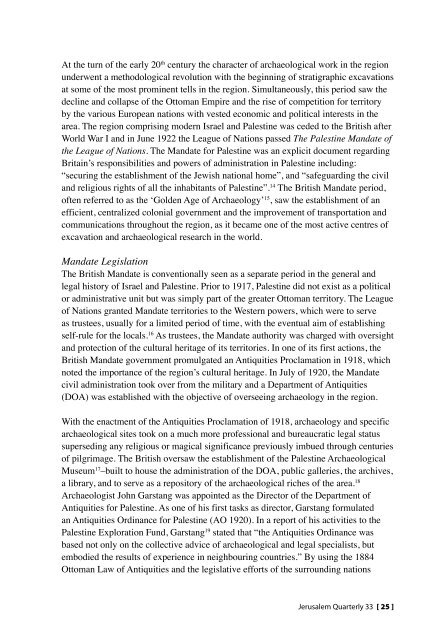
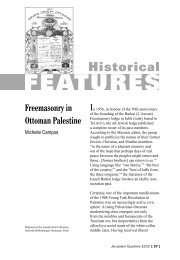
![In Search of Jerusalem Airport [pdf] - Jerusalem Quarterly](https://img.yumpu.com/49007736/1/180x260/in-search-of-jerusalem-airport-pdf-jerusalem-quarterly.jpg?quality=85)
